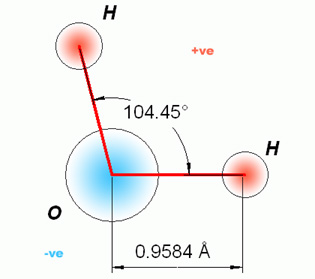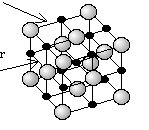


The Law of Attraction (LOA) says that like attracts like.
The Law of Attraction has two aspects: a metaphysical one that seemingly generates non-local phenomena like coincidences, happy accidents, and luck, and another that is reflected in the material world of matter and energy. Therefore, the principle of “like attracts like” is not only reflected in human relationships, but also in the practical behavior of the physical world.
The material universe is composed of collections of fundamental elements called atoms. Atoms are themselves composed of protons, neutrons, electrons and quarks, but for purposes of our discussion, we will call the elements of the Periodic Table the basic elements of our visible world. Water, for example, is composed of two atoms of hydrogen and one of oxygen. The geometric separation between these atoms is approximately 104 degrees. Salt is composed of one atom of sodium and one of calcium. The geometric separation between these elements is 90 degrees. All of the structures of the material world are conglomerations of elements that come together in some fashion. An atom of argon, for example, never combines with an atom of helium. There are very good scientific reasons why these elements do not conglomerate, but the material structures of our world are necessarily combinations. In order to aggregate, atoms have to match up in some way.
In order for something to exist it must have enough materiality, and in order for it to have a materiality it must gather together in order to be perceived. It isn't possible to see an individual atom of copper, for example, but if there are enough of them one can eventually manufacture a copper pipe.
It is clear that combination is the quintessential property of structure. An individual molecule of water surely exists, but trillions of them together combine to form the vastness of the Pacific Ocean.
But how does this combination occur?
Well, the energy of a copper atom, for example, is not different than the energy of an iron atom. They are all composed of neutrons, protons, and electrons. We don't talk about iron energy and copper energy.
The energy within all material substance is the same.
In other words, the energy that composes protons neutrons and electrons is identical no matter what the substance! That energy within water is the same as the energy within salt. So then why are the two substances so different? Why do they exhibit such radically different physical characteristics?
The answer lies in the subject of geometry. Geometry is the most fundamental subject in the universe, for it describes the relationships between all things. That's one of the reasons I have an entire section devoted to geometry on this website.
Lets look at a molecule of water:


The hydrogen atoms (in red) are separated geometrically from the oxygen atom (blue). The manner in which the fundamental energy that composes both elements combine, determines the physical form and properties of 'water.'
Salt is composed of the elements sodium and chlorine. If you put either sodium or chlorine into your mouth you would do yourself great harm. Yet sodium and chlorine atoms have an affinity for each other and they combine to form salt. Sodium chloride tastes pretty good to us.
Heres a diagram of salt:

Sodium atoms are represented as black dots, the chlorine atoms are the larger gray spheres.
There are over a hundred elements in the Periodic Table of elements. The number of possible combinations of these elements is astronomically large. However, there are comparatively few that combine to form the substances of our material world.
We can summarize these combinations by simply saying that like attracts like. Argon has no affinity for helium, and so they do not come together.
So why does like attract like' explain the coming together of elements?
We have already remarked that an atom is just a vibration. It is composed of tiny subatomic particles moving very quickly within a vast emptiness of space. Our scientists tell us that the electromagnetic radiation (light, magnetism, etc.) we perceive with our senses has the characteristics of both particles and waves. Therefore, reality itself has a fundamental vibrational component. Looking at the world vibrationally can lead us to some very important conclusions, the most important of which is the following.
Perception itself requires a matching of vibrations.
The human eye cannot see ultraviolet light, because its frequency is above the frequency range of perception of the human eye.
The human ear cannot hear the dog whistle, because it is beyond the frequency range of the human ear.
Obviously, one cannot be aware of that which is beyond the range of the senses, for one cannot perceive that which is beyond the range of the senses. This is true for each and every life form in every corner of the universe.
Because the human senses of our bodies are composed of atoms, and because atoms are themselves vibrational, the perception of anything (sound, light, feel smell and taste) is an interfacing between vibrations of compatible frequencies.
Therefore, it is a quintessential property of the universe that a thing cannot even be recognized unless by another thing similar to it.
The property of like attracts like reinforces the attractive property of this universe. Attraction is affinity, affinity is love. Therefore all material structure is itself reflective of the idea of affinity. Therefore the entire universe of Form has the fundamental characteristic of harmony.
On our planet, of course, we go to great lengths to abuse this notion. Moralists, politicians, religious figures and even some scientists pillory any who dare to suggest that the inherent structure of the world is positive. Delusional! they say, pointing to the miserable state of our little pile of mud. Well, I would like to point out that probably 90% of this misery occurs in the human race, and not in other species. We are miserable because we have convinced ourselves, against Nature herself, that we are unworthy beings, deserving only of suffering and toil. And we have built our societies around these execrable ideas which go against the design of the universe itself and thus we experience that which we believe to be true. Like attracts like.
The earth is a paradise that we have sullied with our own illogic. However, illogic is easily transmutable to logic. For example, we may lift the rock underneath which festers the illogic that suffering and hard work lead to happiness, by exposing it to the light of day. We may say, accurately, that suffering and hard work lead only to more suffering and hard work. We may then reason that only when suffering and hard work are abandoned can happiness truly arise.
There are, of course, a host of calumnies that we can mention, but they would be too numerous to enumerate. Fighting for freedom is something worth noting. Illuminated by the concept of like attracts like, we may understand that fighting merely leads to more fighting. Now, if you are someone who benefits from war (and there have been many fortunes made because of war), then it would be a great idea to convince the general population that war is a good thing. And thus was the idea of patriotism born, for of course, a certain percentage of the populace (but not those who foment war) must be convinced to take arms and fight these wars. Let us say that a society which believes that those who encourage war are not compelled to participate in them, is a little nutty. We may think that Richard the First (known as Lionheart) was in error when he fomented his Third Crusade against Saladin, almost bankrupting his country, but we must at least give him the credit of having the courage of his convictions. Richard didn't sit in some office or war room while others risked their lives for his beliefs. He was out front with the troops, leading the charge.
Applying the universal concept of like attracts like, one may finally learn how to think, and thus improve one's life, in spite of those who believe otherwise.
So my friends, use the logic of 'like attracts like' to make sense of the world and regain your clarity and sovereignty. The universe itself is built upon this principle, and logic itself mirrors it.